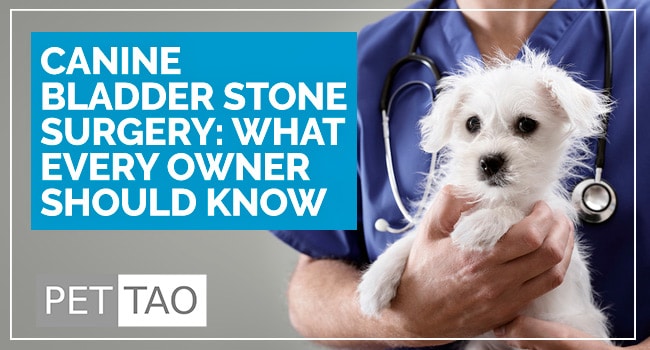Experiencing pain from dog bladder stones can be very challenging and painful for your pup.
Rover has been acting strangely on your morning walks.
He lifts his hind leg and slightly winces.
You notice some straining and a look of pain in his eyes.
As a responsible dog owner, you take Rover to the veterinarian.
You half expect the diagnosis, and then your fear is confirmed.
“Ma’am, I hate to inform you but Rover has bladder stones. The stones are most likely calcium oxalate stones because of the crystals in the urine. We will have to surgically remove them and submit a sample to the lab (Minnesota Dog Urolith Center) for an exact diagnosis.”
Whew! Sounds complicated and expensive!
Thanks to modern veterinary medicine, your dog’s bladder stones can be corrected with surgery.
But now you need answers like:
-
- “How much does surgery cost?”
- “How do I take care of Rover after surgery?”
- “What can I expect after surgery?”
- “What treatments are used after surgery?”
After all his years of loyal companionship, you’re not really sure cost matters.
Rover is family after all, but you still need to know the number.
The cost for Rover’s surgery will range anywhere from $2,000 to $4,000.
A few thousand is a chunk of change for most of us! You want to make sure the surgery sticks at that price.
With so much invested in the surgery, you need more answers.
So what is the best method of caring for a cat or a dog after bladder stone surgery?
Post-surgical care varies.
Obviously, you and your veterinarian want full recovery following cat or dog bladder stone surgery.
Together, you choose the best post-operative care.
In reality, the post-surgical care is very simple and straightforward, much like a spay.
The following are our recommendations:
- No, running, jumping or playing with other dogs for 14 days.
- Use an E-collar! I know you don’t like seeing Rover in a collar but it might save his life.
- Monitor the incision for infection.
- Give copious amounts of fresh (preferably distilled) water.
Dog bladder stone surgery is invasive and traumatic for Rover.
Following surgery, keep an eye on Rover for any signs that he is again having trouble urinating or is in pain.
He will be in some amount of pain from the abdominal incision.
And your veterinarian will give you pain medicine.
However, he still might arch his back or not react quite as quickly as before.
These behaviors are all normal and should resolve 5-7 days after surgery.
Also, give Rover extra attention and love while he recovers and follow all instructions given by your veterinarian.
For cats with bladder stones, the recommendations are the same.
Learn more about dog bladder and kidney stones, how to prevent and how to treat.
Powerful Tools to Help Your Dog’s Urinary Tract & Bladder Challenges
There are many quick and easy changes you can make at home to help your give your dog an edge on easing urinary tract challenges.
- Learn more about dog bladder and kidney stones.
- Provide bladder support. PET | TAO’s Soothe Bladder is a blend of Eastern herbs and Western supplements working together to soothe your dog’s bladder and urinary tract..
- Consider a Cooling Diet. PET | TAO’s Chill cools inflammation caused by infection. Make sure to discuss any dietary changes with your holistic vet.
- Try PET | TAO Freeze Dried Beef Kidney Treats. According to TCVM, kidney controls kidney, bladder, and urinary tract functions. As few as 5-6 treats per day can make a huge difference in your urinary tract and bladder health!
- Learn more about TCVM Herbal Remedies. Chinese medicine offers many amazing natural solutions for canine bladder and urinary health challenges. Some good examples are:








